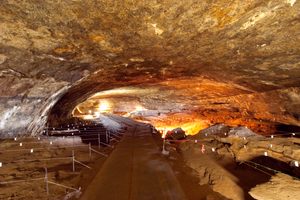
Over a million years ago, one of our ancient ancestors took a burning stick from a wildfire and carried it into a dark cave in South Africa. Light danced on the walls as our hominin forebear (Homo Erectus, that is, not quite modern humans just yet) placed the burning stick on a pile of twigs, which burst into flames. Or at least, this is the scene we might imagine based on evidence found in Wonderwerk Cave.
Controlled fire—aka a campfire—was one of the most important breakthroughs in our soon-to-be-human history. Mastering fire allowed our great-great-great- (add about 40,000 more greats) grandparents to stay warm, light up the night, and keep predators at bay. Most importantly, it meant they could roast their food. Cooking made food easier to chew and digest, unlocking significantly more calories and nutrients than raw food. The innovation of fire and its impact on early diets is also believed to have played a major role in increasing brain size among our early human ancestors over the next half-million years.
Wonderwerk Cave traces this early culinary history. Inside the 456-foot-long (139-meter) cavity, signs of ancient fires suggest people cooked food here about a million years ago. Buried deep in the rock, archeologists and scientists found the ashy, burnt remains of grasses, leaves, and animal bones. This discovery ranks as some of the earliest evidence of controlled fire.
While this is the oldest currently accepted evidence for hominid controlled fire, it is certainly possible that hominid controlled fire may date back as far as 2 million years ago.
0 comments:
Post a Comment